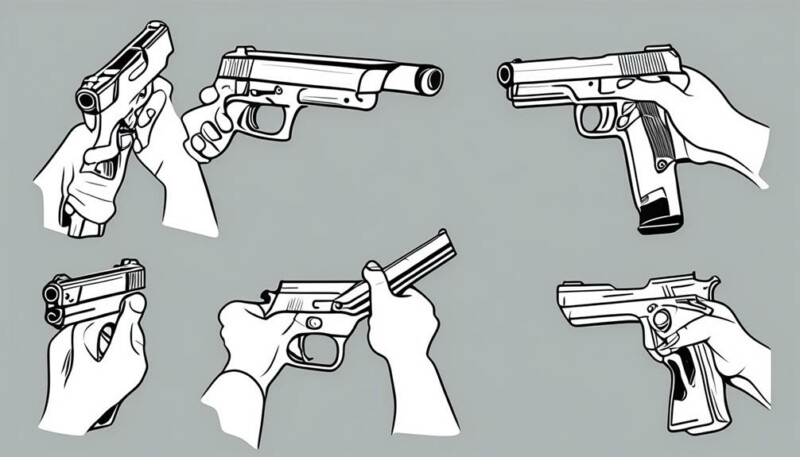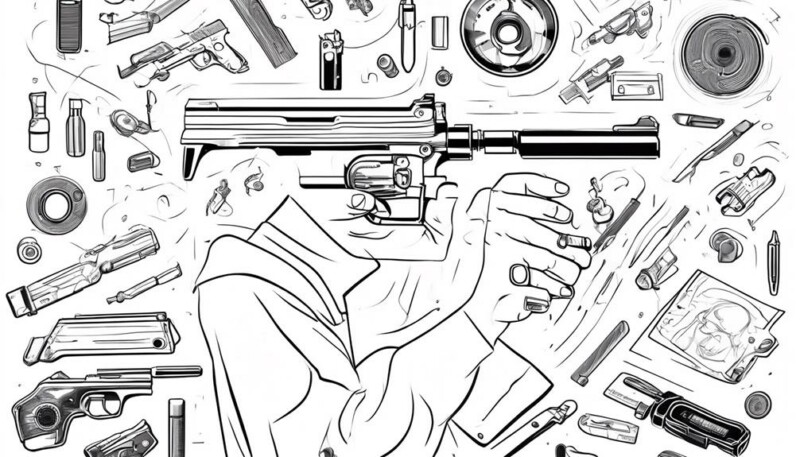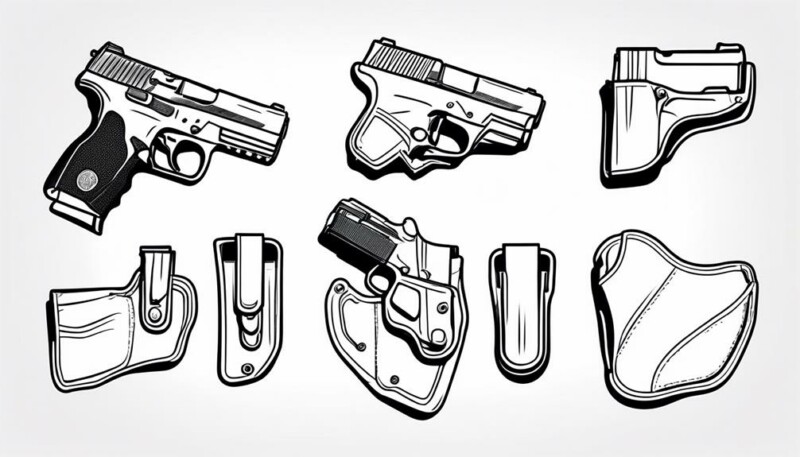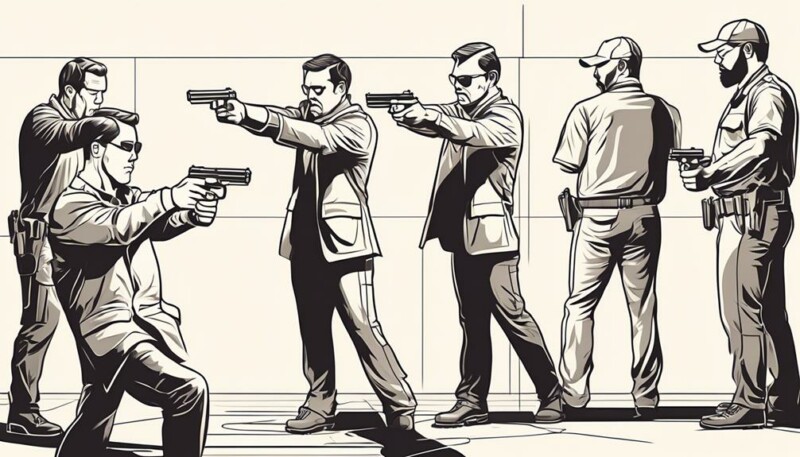You may think that carrying a concealed firearm gives you a sense of security, but it also comes with a great deal of responsibility. Concealed carry firearm safety entails more than just obtaining the necessary permits and licenses.
It involves a comprehensive understanding of state laws, regular practice and maintenance of your firearm, and developing the right mindset to handle potential threats. But that's just scratching the surface.
There are many other crucial aspects to consider when it comes to concealed carry firearm safety, and by exploring them further, you'll gain a deeper understanding of what it truly entails.
Key Takeaways
- Concealed carry firearm safety entails responsible and safe handling of firearms while carrying them in public.
- It is crucial to comply with state laws and regulations regarding concealed carry.
- Proper storage techniques and secure holsters are essential to prevent unauthorized access and accidental discharges.
- Training is of utmost importance to develop the necessary skills, knowledge, and confidence for safely carrying a concealed firearm.
Importance of Firearm Safety Training
Firearm safety training is crucial for ensuring responsible and safe handling of firearms in various situations, reducing the risk of accidents, and maintaining proficiency with a concealed carry firearm.
When you carry a concealed handgun, it's essential to understand the importance of proper training. It not only helps you comply with state laws and regulations but also equips you with the necessary skills to handle your firearm safely and effectively.
By undergoing firearm safety training, you gain a thorough understanding of the laws related to carrying a concealed firearm in your state. This knowledge is crucial in avoiding legal complications and ensuring that you adhere to all necessary requirements. Additionally, training provides you with the confidence to handle your handgun responsibly, reducing the likelihood of accidents and injuries.
Moreover, firearm safety training helps you maintain proficiency with your concealed carry firearm. Regular practice and training sessions enhance your marksmanship skills, allowing you to effectively defend yourself in self-defense situations. Advanced training can provide you with a tactical advantage and help you make quick, informed decisions when faced with a potential threat.
Basic Firearm Safety Rules

Now let's shift our focus to the essential topic of firearm safety rules, ensuring responsible and safe handling of your concealed carry firearm. Adhering to these basic rules is crucial for anyone carrying a concealed weapon. By following these guidelines, you can minimize the risk of accidents and promote firearms safety.
| Firearm Safety Rules | Description |
|---|---|
| Always keep the firearm pointed | This rule emphasizes the importance of keeping the muzzle pointed in a safe direction, away from people and vulnerable objects. |
| in a safe direction. | It ensures that even if an accidental discharge occurs, no harm will be caused. |
| Keep your finger off the trigger | By keeping your finger off the trigger until you are ready to shoot, you prevent unintentional discharges and potential injuries. |
| until you are ready to shoot. | This rule emphasizes the need for trigger discipline and reinforces the importance of maintaining control over your firearm. |
| Be aware of your target and what's | It is crucial to know your target and what lies beyond it to prevent unintended damage or injury. |
| beyond it. | This rule ensures that you have a clear line of sight and can make informed decisions before discharging your firearm. |
| Store firearms securely to | Proper storage of firearms is essential to prevent unauthorized access. This includes using lock boxes, safes, or gun cabinets. |
| prevent unauthorized access. | By securing your firearm, you reduce the risk of accidents, theft, or misuse by unauthorized individuals. |
| Understand the laws and | Familiarize yourself with the laws and regulations regarding carrying a concealed handgun in your state. |
| regulations regarding concealed | Knowing the legal requirements helps you stay compliant and responsible when carrying a firearm. |
| carry in your state. | It ensures that you are aware of any restrictions or obligations associated with carrying a concealed firearm. |
Safe Handling and Storage of Firearms
When it comes to the safe handling and storage of firearms, there are several important points to consider.
First, proper storage techniques are crucial in preventing accidents and unauthorized access.
Second, always handle firearms with care, keeping your finger off the trigger until you're ready to shoot and pointing the muzzle in a safe direction.
Lastly, understanding and practicing gun safety is of utmost importance to ensure the well-being of yourself and those around you.
Proper Storage Techniques
To ensure the safe handling and storage of firearms, it's crucial to implement proper storage techniques that prioritize security and accessibility. Proper storage techniques include keeping firearms in a locked container, such as a safe or a lockbox, to prevent unauthorized access. It's also important to store ammunition separately from firearms. By following these guidelines, you can ensure that your firearms are stored safely and securely.
When it comes to concealed carry and firearm safety, it's important to adhere to the regulations set forth by Texas law. In Texas, a license to carry is required for individuals who wish to carry a concealed handgun in public. The Texas Department of Public Safety oversees the licensing process, which includes a background check and completion of training requirements.
Handling Firearms With Care
Practice and familiarization with your firearm are essential for safe handling and storage. To ensure you handle your concealed carry firearm with care, follow these guidelines:
- Practice and Familiarization: Efficiently drawing and firing a concealed weapon is crucial in times of disaster. Regularly practice drawing your weapon from your holster and build muscle memory by consistently wearing your holster in the same location. Also, practice drawing and firing from different carry positions to be prepared for any situation.
- Maintenance and Reliability: Regularly maintain your firearm to ensure its reliability. Neglecting maintenance can lead to failures in firing, feeding, or ejecting. Clean your gun following the manufacturer's recommendations, remove residue buildup, and ensure every mechanism works properly. Don't forget to oil your gun for smooth operation.
- Safe Handling and Direction: Always keep the front end of your gun in a safe direction to prevent injury or property damage if the gun goes off. Remember that bullets can penetrate walls and ceilings, so be cautious. Choose a secure holster for off-body carry to prevent your weapon from sliding around, and use concealed carry bags with holsters to keep your weapon securely in place.
- Finger Off the Trigger: Keep your finger off the trigger unless you intend to shoot. Holding your finger outside the trigger guard prevents accidental discharge. Make proper form a habit to minimize risks, and avoid falling with your finger inside the trigger guard to prevent unintentional firing. Stay off the trigger until you're ready to fire.
Importance of Gun Safety
Gun safety is of utmost importance for ensuring the secure handling and storage of firearms.
If you plan on carrying a concealed weapon, it's crucial to receive proper firearm safety training. This training will equip you with the necessary knowledge and skills to handle your firearm safely and responsibly.
Regular practice and familiarization with your firearm are also essential to ensure effective and safe handling.
Additionally, maintaining and ensuring the reliability of your firearm is crucial for its safe and effective operation.
Understanding your state's permit requirements and laws regarding concealed carry is equally important. This includes knowledge of background checks, permits, and any specific training requirements mandated by your state.
Understanding and Preventing Accidental Discharges

To ensure firearm safety and prevent accidental discharges, it's crucial to follow safety rules and protocols.
Proper handling of firearms, such as keeping your finger off the trigger until ready to shoot and always pointing the muzzle in a safe direction, can greatly reduce the risk of unintentional firing.
Additionally, it's important to emphasize the significance of receiving proper training in order to understand the potential dangers and gain the necessary skills to handle firearms responsibly.
Safety Rules and Protocols
Understanding and preventing accidental discharges is crucial for ensuring the safety of yourself and those around you while carrying a concealed firearm. To maintain a safe environment, it's important to follow these safety rules and protocols:
- Keep the front end of your gun pointed in a safe direction at all times. This ensures that if the gun were to accidentally discharge, no one would be injured or property damaged.
- Keep your finger off the trigger until you're ready to shoot. By doing this, you minimize the risk of accidentally pulling the trigger and causing an unintended discharge.
- Regularly practice drawing and firing your concealed weapon from different carry positions. This helps build muscle memory and ensures a quick and accurate response in case of an emergency.
- Regularly maintain your firearm to prevent any failures in firing, feeding, or ejecting. This ensures the reliability of your weapon when you need it most.
Proper Firearm Handling
When handling a firearm, it is crucial to understand and prevent accidental discharges for the safety of yourself and those around you. Proper firearm handling is essential, especially for concealed carry permit holders who legally carry a firearm in public. In Texas, the state law allows open carry of firearms, but concealed carry requires a permit issued by the Texas Department of Public Safety. It is important to familiarize yourself with both federal and state laws regarding firearm safety and eligibility requirements. To help you understand the importance of proper firearm handling, here is a table that highlights key safety practices:
| Proper Firearm Handling | Preventing Accidental Discharges |
|---|---|
| Always keep the muzzle pointed in a safe direction | Keep your finger off the trigger until ready to shoot |
| Treat every firearm as if it is loaded | Be aware of your target and what is beyond it |
| Know your target and what is beyond it | Keep the firearm unloaded until ready to use |
| Keep your finger off the trigger until ready to shoot | Store firearms securely to prevent unauthorized access |
Importance of Training
Proper training is essential for understanding and preventing accidental discharges when handling firearms. Whether you're someone who wants to carry without a permit or a law enforcement officer, training is crucial for everyone's safety. Here are four reasons why training is of utmost importance:
- Familiarity: Training helps you become familiar with your handgun, its components, and how it functions. This knowledge enables you to handle the firearm confidently and safely.
- Safety Protocols: Training teaches you the necessary safety protocols and best practices for handling firearms, reducing the risk of accidental discharges.
- Legal Compliance: Understanding the laws surrounding concealed carry and firearm safety is essential. Training provides you with the knowledge of the legal requirements and responsibilities, ensuring you remain compliant and avoid legal troubles.
- Confidence: Training builds your confidence in your abilities to handle firearms safely. It helps you develop muscle memory, making it easier for you to react correctly in high-stress situations.
Holster Selection and Proper Carry Methods

To ensure safe and effective concealed carry, selecting the right holster and carrying method is essential. Your choice of holster should securely and comfortably fit your firearm, allowing for proper concealment and easy accessibility. It is crucial to practice different carry positions with an unloaded firearm to find the most comfortable and secure method for you. Additionally, your holster should cover the trigger guard to prevent accidental discharges and securely retain the firearm. Regularly practicing drawing your weapon from the holster helps build muscle memory for quick and accurate response in case of an emergency.
Here is a table summarizing the key considerations for holster selection and proper carry methods:
| Considerations | Tips |
|---|---|
| Holster Fit | Choose a holster that securely and comfortably fits your firearm for proper concealment and accessibility. |
| Trigger Guard | Ensure the holster covers the trigger guard to prevent accidental discharges and enhance the safety of carrying a loaded firearm. |
| Practice Drawing | Regularly practice drawing your weapon from the holster to build muscle memory for quick and accurate response. |
| Maintenance | Prioritize proper maintenance of your holster and firearm to ensure reliability and safe carry. Regularly inspect and clean both for optimal use. |
Situational Awareness and Threat Assessment

Maintaining situational awareness and assessing potential threats is crucial for ensuring your safety while carrying a concealed firearm. By being aware of your surroundings and evaluating potential dangers, you can better protect yourself and others.
Here are four key points to consider when it comes to situational awareness and threat assessment:
- Pay attention to your surroundings: Always be aware of what's happening around you. Scan the area for any suspicious activities or individuals who may pose a threat.
- Trust your instincts: If something feels off or gives you a bad feeling, trust your gut. Your intuition can often alert you to potential dangers before they escalate.
- Stay informed: Keep up to date with the latest news and developments in your community, especially regarding gun violence or incidents in K-12 schools. This knowledge can help you assess potential threats and take appropriate precautions.
- Understand concealed carry laws: Familiarize yourself with the concealed carry laws in your state. Knowing your rights and responsibilities under these laws can help you make informed decisions and ensure you're carrying your firearm legally and responsibly.
Continual Training and Skill Development

As you continue to prioritize your safety while carrying a concealed firearm, one crucial aspect to focus on is continually training and developing your skills. It is not enough to simply obtain a concealed carry permit or complete an approved online course. Ongoing training is essential to ensure that you are prepared to handle any situation that may arise.
Continual training allows you to stay proficient in using your firearm safely and effectively. It helps you maintain muscle memory and develop the necessary skills to react quickly and accurately in high-pressure situations. Regular practice also helps you become familiar with your firearm's operation and increases your confidence in handling it.
To illustrate the importance of continual training and skill development, here is a comparison table:
| Without Continual Training | With Continual Training |
|---|---|
| Limited proficiency | High proficiency |
| Lack of confidence | Increased confidence |
| Inefficient response | Quick and accurate response |
| Higher risk of accidents | Lower risk of accidents |
Law enforcement officers undergo continual training to ensure they can effectively protect and serve the public. As a responsible concealed carry permit holder, it is your duty to uphold the same level of preparedness. By investing time and effort into continual training, you are demonstrating a commitment to firearm safety and the well-being of yourself and those around you.
Frequently Asked Questions
Do Concealed Carry Guns Have Safety?
Yes, concealed carry guns do have safety features. They're designed to prevent accidental discharge and ensure safe handling.
However, it's important to remember that relying solely on the safety features isn't enough. Proper firearms training, understanding handgun safety, and following concealed carry laws and best practices are essential for safe concealed carry.
Additionally, using high-quality concealed carry holsters and accessories can enhance safety and accessibility while carrying a firearm.
What Are the 10 Rules of Gun Safety?
When it comes to gun safety, there are ten crucial rules you need to follow.
First, always keep your finger off the trigger until you're ready to shoot.
Second, maintain a proper grip on your firearm.
Third, choose a holster that securely holds your weapon.
Fourth, get trained on how to use your firearm effectively.
Fifth, practice situational awareness to avoid dangerous situations.
Sixth, store your firearm safely.
Seventh, follow shooting range etiquette.
Eighth, learn proper weapon retention techniques.
Ninth, be mentally prepared for any situation.
And finally, understand your legal responsibilities.
Stay safe out there!
What Are the Requirements for Concealed Carry in Texas?
To carry a concealed handgun in Texas, you must meet certain requirements. These include completing handgun training, undergoing background checks, and going through the application process. Once you have obtained a license, it must be renewed periodically, and you'll need to acknowledge state laws and prohibited carry locations.
It's important to understand open carry laws, self-defense laws, and any reciprocity agreements with other states. Additionally, proper firearm storage is crucial for safety.
Can I Conceal Carry in Walmart in Texas?
Yes, you can conceal carry in Walmart in Texas, as long as you comply with Walmart's policy and Texas laws. While open carry is generally prohibited in Walmart stores, concealed carry is allowed with the proper license.
Concealed carry offers benefits like personal protection and the ability to defend yourself in dangerous situations. However, it's important to remember that there are restrictions and responsibilities that come with carrying a firearm, including the need for firearms training and adherence to self-defense laws.
Understanding concealed carry statistics, public perception, and concealed carry reciprocity is also essential.
Conclusion
So, there you have it – the essentials of concealed carry firearm safety. Remember, regular practice and familiarization with your firearm, along with proper maintenance and storage, are crucial for safe handling.
Always keep your finger off the trigger until ready to shoot, and be aware of your target and surroundings.
One interesting statistic to note: a study found that states with more relaxed concealed carry laws actually had higher rates of firearm accidents, emphasizing the importance of responsible carry and adherence to safety guidelines.
Stay safe and always prioritize firearm safety.
